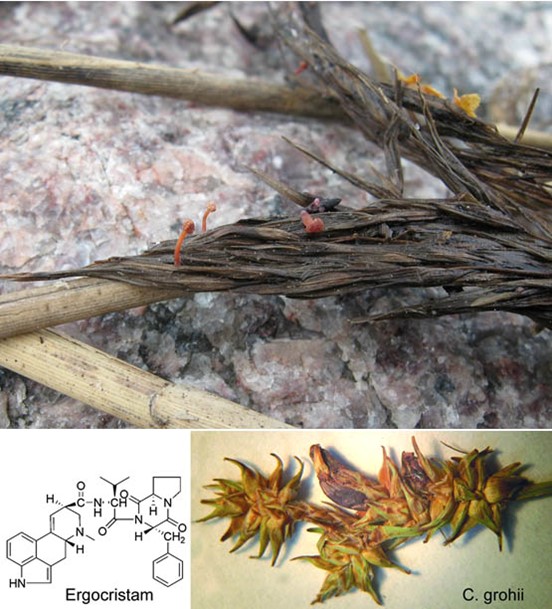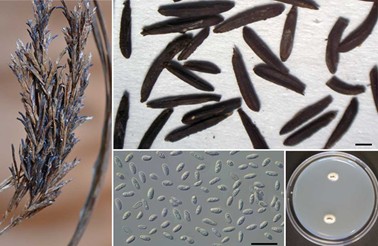Evolution, ecology, diversity and toxicity of ergot, the genus Claviceps
The genus Claviceps (Ascomycota, Hypocreales), known as ergot, includes over 60 species that parasitize the inflorescences of grasses, including cultivated cereals. These fungi are significant in agriculture, food industry, and pharmacy. They are notable for their production of toxic ergot alkaloids, which cause poisoning but are also sources of pharmaceuticals. A former team member, Dr. Sylvia Pažoutová, dedicated her professional life to the study of ergot. She passed away suddenly in September 2013, and we continue her work. Our laboratory holds the world’s largest collection of ergot fungi (Culture Collection of Clavicipitaceae, CCC) and focuses on the research of the evolution, diversity, toxicity, taxonomy, and ecology of these fungi.


Claviceps purpurea
Among other findings, we discovered that the rye pathogen, Claviceps purpurea, is a complex of several related species with different host ranges. This is crucial for protecting field crops from this toxic cereal pathogen. We were the first to reconstruct the evolutionary history of the entire genus, revealing that it consists of several distinct groups (described as sections) with different host ranges, geographical distributions, and toxicities. Our team has described dozens of new ergot species from around the world. We also pointed out to the neglected role of erchochrome metabolites in overall ergot toxicity.
The main results are summarized in the following works, which also highlight the extent of our international collaboration, including teams from Canada, Japan, the USA, South Africa, and other countries.
- Pazoutova S, Pesicova K, Chudickova M, Srutka P, Kolařík M (2015) Delimitation of cryptic species inside Claviceps purpurea. Fungal Biology 119: 7-26.
- van der Linde EJ, Pešicová K, Pažoutová S, Stodůlková E, Flieger M, Kolařík M (2016) Ergot species of the Claviceps purpurea group from South Africa. Fungal Biology 120: 917-30.
- Píchová K, Pažoutová S, Kostovčík M, Chudíčková M, Stodůlková E, Novák P, Flieger M, van der Linde E, Kolařík M (2018) Evolutionary history of ergot with a new infrageneric classification (Hypocreales: Clavicipitaceae: Claviceps). Molecular Phylogenetics and Evolution 123: 3-87.
- Flieger M, Stodůlková E, Wyka SA, Černý J, Grobárová V, Píchová K, Novák P, Man P, Kuzma M, Cvak L, Broders KM, Kolařík M (2019) Ergochromes: heretofore neglected dide of rrgot toxicity. Toxins 11: 439
- Liu M, Findlay W, Dettman J, Wyka SA, Broders K, Shoukouhi P, Dadej K, Kolařík M, Basnyat A, Menzies JG (2021) Mining indole alkaloid synthesis gene clusters from genomes of 53 Claviceps strains revealed redundant gene copies and an approximate evolutionary hourglass model. Toxins 13: 799.
- Liu M, Tanaka E, Kolařík M (2022) Neotypification of Claviceps humidiphila and recognition of C. bavariensis sp. nov. Mycotaxon 137: 73-87.
- Liu M, Kolařík M, Tanaka E (2022) The 168-year taxonomy of Claviceps in the light of variations: From three morphological species to four sections based on multigene phylogenies. Canadian Journal of Plant Pathology, 44: 783–792
- van der Linde EJ, Píchová K, Pažoutová S, Stodůlková E, Flieger M, Novák P, Kolařík M (2022) Pre-invasion assessment on African invasive grasses revealed five new species of ergot fungi, Claviceps section Pusillae. Fungal Biology 126: 752-763
- Tanaka E, Tanada K, Hosoe T, Shrestha B, Kolařík M, Liu M (2023) In search of lost ergots: phylogenetic re-evaluation of Claviceps species in Japan and their biogeographic patterns revealed. Studies in Mycology 106: 1–39